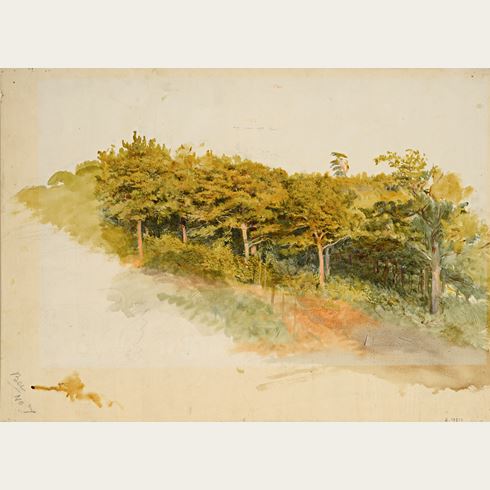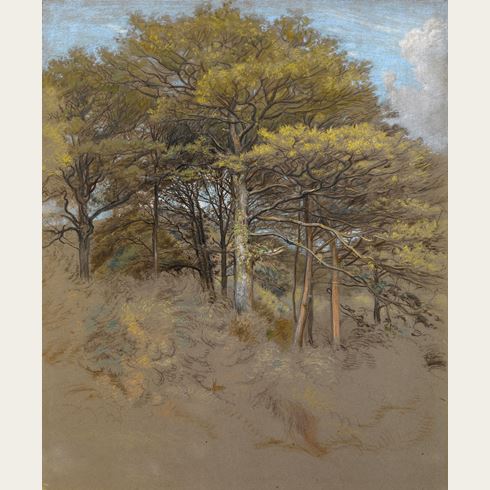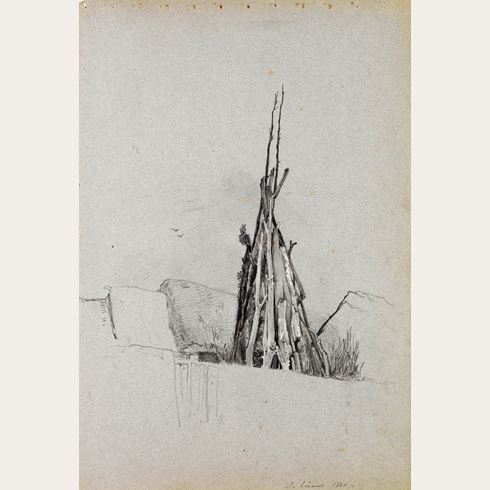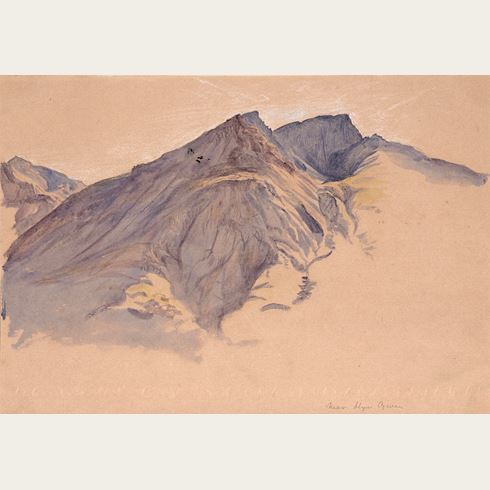James Thomas LINNELL
(Hampstead 1820 - Redhill 1905)
A Surrey Landscape
Sold
Watercolour and bodycolour, over an underdrawing in pencil, on blue paper.
Small made-up sections at the upper corners.
368 x 533 mm. (14 1/2 x 21 in.) [sheet]
Small made-up sections at the upper corners.
368 x 533 mm. (14 1/2 x 21 in.) [sheet]
The present sheet almost certainly depicts a view near the Linnell home of Redhill in Surrey. Cara Denison has succinctly described the artist’s technique in this watercolour: ‘In this sweeping landscape, James varied the concentration of brilliant colors to suggest a beautiful late summer day in the country. The densest application is reserved for the wheat in the foreground, which he stroked on in a pale but brilliant yellow, using lighter washes of dark green for the foliage and deep blue for the background of farms and receding hills.’
Another recent scholar has identified a religious undertone in the composition of the present sheet: ‘John Linnell…raised his children to see the fertile fields as expressions of God’s blessing. He trained his son, James, as a painter, and James’s work was geared toward religious subjects and landscapes. A clear testament to divine beneficence is found in his drawing of newly harvested wheat sheaves in Surrey, where the family had moved in 1857. There is a hymnlike harmony between the warm-toned fields in the foreground and the cooler hills beyond, all composed as a celebration of God’s bounty. The overall unity is achieved by the use of a sheet of blue tinted paper, which, while serving the practical purpose of acting as a middle tone, also assumes a metaphoric quality by symbolizing the existence of an omnipresent deity whose hand lies behind everything as the creator of all things. The drawing might almost be an illustration of the words of the sixty-fifth Psalm: “The valleys also are covered over with corn; they shout for joy, they also sing.”’
Another recent scholar has identified a religious undertone in the composition of the present sheet: ‘John Linnell…raised his children to see the fertile fields as expressions of God’s blessing. He trained his son, James, as a painter, and James’s work was geared toward religious subjects and landscapes. A clear testament to divine beneficence is found in his drawing of newly harvested wheat sheaves in Surrey, where the family had moved in 1857. There is a hymnlike harmony between the warm-toned fields in the foreground and the cooler hills beyond, all composed as a celebration of God’s bounty. The overall unity is achieved by the use of a sheet of blue tinted paper, which, while serving the practical purpose of acting as a middle tone, also assumes a metaphoric quality by symbolizing the existence of an omnipresent deity whose hand lies behind everything as the creator of all things. The drawing might almost be an illustration of the words of the sixty-fifth Psalm: “The valleys also are covered over with corn; they shout for joy, they also sing.”’
The second son of the landscape painter John Linnell, James Thomas Linnell studied at the Royal Academy Schools alongside his two brothers John and William. (His sister Hannah married the artist Samuel Palmer, whose influence can be seen in much of James’s work.) According to a contemporary biographical dictionary, James Thomas Linnell ‘inherited not a little of his father’s talent’, although his palette was perhaps somewhat brighter. He exhibited almost annually at the Royal Academy between 1850 and 1888, at first showing religious subjects in which the landscape predominated; The Temptation in the Wilderness, exhibited in 1850, was followed a year later by Job and the Messengers. By the middle of the decade, however, he was exhibiting mainly landscapes with peasants, farm labourers or children - with titles such as Wheat-Field, Haymakers, Plowing, A Country Road and A Mower whets his Scythe - and it is for these pastoral landscapes that he is best known today. Works by James Linnell are today in the museums of Bradford, Brighton, Cardiff, Gateshead, Harrogate, Leeds, Manchester, Okehampton, Sheffield, Rochdale and Wolverhampton.
Many of James Thomas Linnell’s landscapes were painted in and around the Redstone estate at Redhill, near Reigate in Surrey, which his father John Linnell had acquired in 1851 and where all the members of the family lived. Writing in 1872, one critic noted that ‘James Thomas Linnell...is entitled to share with his brother William the estimation in which their pictures are held by the amateur and collector, sometimes rivalling even those of his father...It is so rare an occurrence to find a picture by any one of the Linnell family bearing the distinctive title of the place represented, that one would naturally be led to suppose the compositions are merely imaginary; but this, as a rule, is far from the case. Surrey, and the wealds of Sussex, supply the artists with the ground-work of most of their beautiful compositions, and the localities may generally be recognized by those who are well acquainted with them.’
Provenance
By descent in the family of the artist
Somerville and Simpson, London, in 1980
Charles Ryskamp, New York.
Literature
William M. Griswold et al., The World Observed: Five Centuries of Drawings from the Collection of Charles Ryskamp, exhibition catalogue, New York, 2001, pp.102-103, no.92 (entry by Cara Denison); Matthew Hargraves, Varieties of Romantic Experience: British, Danish, Dutch, French and German Drawings from the Collection of Charles Ryskamp, exhibition catalogue, New Haven, 2010, p.169, no.135, illustrated p.171.
Exhibition
New York, The Pierpont Morgan Library, The World Observed: Five Centuries of Drawings from the Collection of Charles Ryskamp, no.92; New Haven, Yale Center for British Art, Varieties of Romantic Experience: British, Danish, Dutch, French and German Drawings from the Collection of Charles Ryskamp, 2010, no.135.








